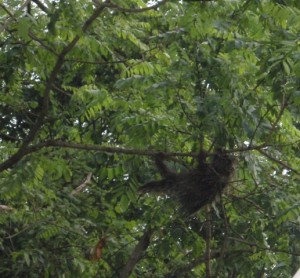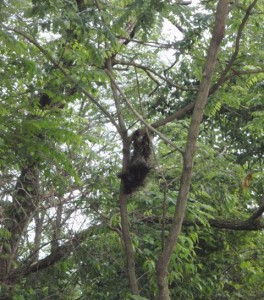Porcupines
We don’t have porcupines (Erethizon dorsatum) at Mariton (they are absent from the Lehigh Valley southward). They are however abundant across Pennsylvania’s northern tier. Last weekend, Maureen and I were camping with friends around Trout Run, PA. Our friend spotted a young porcupine in a tree along the edge of the field where we were camped. It was early in the morning, so we woke up our other friends and their children to see the spectacle.
We pulled up our chairs and sat back to enjoy the show. I have seen more than a few porkies over the years, but I don’t have the experience of watching them for long periods. So, I relied on my buddy’s experience. As we watched this little guy working out on a little branch it suddenly swung upside down. It was more of a slip, but Frank declared he had never seen a porcupine hang upside down.
It eventually got itself back upright on the branch. It was an agonizing process, and my abdominal muscles ached just watching it. It worked its way back to the tree trunk and started down head first. Frank then said: “This is two firsts for me. I’ve never seen one come down head first. They always back down the tree!”
Frank was probably right; because it only went a little ways when it fell out of the tree. The fall knocked the wind out of the little guy, but it was breathing when we checked it. About an hour later, I checked again and it had regained its composure. Later that afternoon, it was back munching on the same branch where we originally had seen it.
Porcupines are adapted for life in the trees. Their feet are big, and flat, and covered with tubercles which give them traction. They also have strong claws for gripping bark. Since porkies like eating the inner bark of trees, they need to be good at getting out on the small branches where the cambium is the most succulent. This little fellow is getting his training through experience, and a few hard knocks.


